Top News

May 18, 2012 Yukito Toyama of Ryukyu Shimpo
On May 10, Children’s Day, the Kitanakagusuku Elementary School served grilled common dolphinfish (Coryphaena hippurus) or manbika in Uchinaguchi in school lunches, cooking the fish in its original shape in the likeness of the colorful carp banners. Before lunch, about 120 first-year pupils visited the Kitanakagusuku School Food Supply Center and saw the staff cooking the manbika. The children squealed in excitement when they saw the big fish, which were over one meter (39.4 inches) long.
The School Food Supply Center has offered manbika in school lunches for the last 14 years as part of dietary education and from the standpoint of local production for local consumption. They supplied them to Shimabukuro Elementary School on May 9 and to Kitanakagusuku Junior High School on May 11.
In class no. 4 of the first grade in Kitanakagusuku Elementary School, the pupils skillfully separated the fish from the bone, with some them saying, “It tastes good” and “I’d like some more!”
Kenji Sonan, the director of the School Food Supply Center, said that he saw a child who drew a fillet as a picture of fish, and this was one of reasons that they started the manbika school lunch. “It is very important to give children ideas in dietary education. I hope that through the manbika lunch these children remember their school lunches for the rest of their lives.”
(English translation by T&CT, Lima Tokumori and Mark Ealey)
Go to Japanese

May 15, 2012 Kenta Masuda and Ryota Shimabukuro of Ryukyu Shimpo
Farmer and anti-war landowner Zenyu Shimabukuro, who owns land inside Kadena Air Base and Camp Shields, continues to refuse to provide that land for military use. He says, “A radish and a bomb may have a similar shape, but a radish doesn’t hurt anyone. The land is to be used for cultivation of crops not to kill people. That’s the way Okinawa used to be.” He imagined a green landscape on the island where military bases have stayed for 40 years since the reversion.
Now 75 years old, in May 1977, Shimabukuro started plowing his field in Camp Shields with heavy machinery. The National Diet was thrown into disorder when the Special Measures Law for Land Used by the American Forces, which had enabled the military use of the land, expired, four days were left undetermined for the use of the land. Shimabukuro said “There was no law governing this and the land is for the Uchina people.” So he took his wife, children, and ducks with him, Shimabukuro entered the base and started plowing the land. The military personnel were dumbfounded as he transformed lawn into a field with heavy machinery. When staff of the Defense Facility Agency told him how beautiful the lawn was, Shimabukuro replied that to him it was just weeds and went ahead and planted garlic in the newly created field.
At his house in Chibana, Okinawa City, Shimabukuro still keeps a bell made from a gas canister that was used to ring in an emergency during the time of the U.S. military administration when U.S. soldiers acted violently in the community.
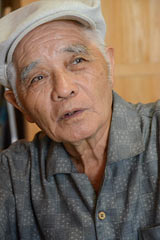
On May 11, 2012 in Okinawa City, Zenyu Shimabukuro talked about the 40 years that have passed since the reversion.
His refusal to offer the land to the U.S. military has its origins in land seizures in Isahama, Ginowan Village in July 1955. At that time, Shimabukuro was attending Chubu Norin High School studying to become a farmer. One afternoon, he witnessed how U.S. military heavy machinery was used to seize and flatten fields despite residents’ opposition. He remembers feeling as though his dreams had also been squashed. U.S. military personnel with heavy equipment gathered in the middle of the night and the land was seized in the early hours of the morning.
After graduating from high school, Shimabukuro went to Hawaii on a scholarship from the U.S. Civil Administration to study agriculture. This made him feel closer to the United States, but after he returned to Okinawa, on June 30, 1959, a military aircraft crashed into Miyamori Elementary School in Ishikawa. The next day, Shimabukuro rushed to the site and on the ground saw glass Coca Cola bottles deformed by the heat. He imagined how incredibly hot it must have been for the people who died. He has never drunk Coca Cola again.
He brought the glass from a Coca Cola bottle back home and started keeping records of major accidents and crimes by the U.S. military since the Battle of Okinawa. The record or these kept as a scroll now exceeds 20 meters in length, and he is on to the second one. Accidents and crimes caused due the presence of the military still kept recorded despite the reversion of Okinawa to Japanese sovereignty.
At the end of last year, one event vividly reminded Shimabukuro of the land seizure in Isahama. It was when before dawn the Okinawa Defense Bureau submitted the environmental impact assessment report for construction of replacement facilities for the United States Marine Corps Air Station Futenma to the Okinawa Prefecture Government.
Shimabukuro said, “They aimed at the time just before dawn when their opponents were asleep, so the methods that they use to force through the construction of military bases have not changed at all.” Reflecting on 40 years since the reversion of Okinawa to Japanese sovereignty, he comments, “Things that have not changed after 40 years will not have changed even after 100 years. We hoped that the reversion to change the situation, but…. On the occasion of this 40th anniversary, we should also think about how everything started.”
(English translation by T&CT, Megumi Chibana and Mark Ealey)
Go to Japanese
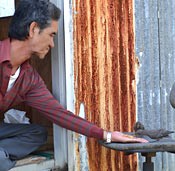
May 16, 2012 Ryukyu Shimpo
A family of blue rock thrush make an appearance picking food from a man’s hand in Midorimachi, Uruma.
Seiki Agena has been feeding them breadcrumbs from the middle of April. From this month they have come with their four little ones, and have started to take food from Agena’s hand since May 6.
Agena said, “When I open the front door at around 8:00am, they are already waiting for me on the bike. They are so cute.”
(English translation by T&CT, Shinako Oyakawa and Mark Ealey)
Go to Japanese

May 16, 2012 Ryukyu Shimpo
On May 4, at the Nakata Shokai in Sesoko, Motobu, the annual goat-fighting, or pijaorasai event was held. Goats from Sesoko Island and Katsuyama in Nago took part in 16 bouts. Surrounded by the smell of goat soup, they smashed their horns against each other fiercely.
On this day, Teruya-five participated in four bouts and displayed a seemingly boundless fighting spirit. In the last bout, he caught the hoof of his opponent, Kunjan, in an unguarded moment and Kunjan let out a shriek.
In the bout between Yoshihata and Tokara-two, Tokara-two attacked bravely early in the piece but Yoshihata responded by pretending to flee, before fighting back with sheer power and finally getting Tokara-two out beyond the fence.
The pijaorasai in Sesoko Island is held every year in May and November. Wataru Nakada, the president of the Sesoko Island Pijaorasai Preservation Society, said, “These days, there are some goats that don’t know how to fight, but I will train them up for November’s event.”
(English translation by T&CT, Lima Tokumori and Mark Ealey)
Go to Japanese

May 13, 2012 Hideki Matsudo of Ryukyu Shimpo reports from Washington D.C.
On May 11, in Washington D.C., former U.S. Government senior official Morton Halperin, who in the past was responsible for negotiating with the Japanese Government on matters relating to the reversion of Okinawa to Japanese sovereignty, responded to a request from the Ryukyu Shimpo for an interview. Four decades ago, he drafted the National Security Decision Memorandum 13 (NSDM 13), a top-secret file that summarized U.S. policy on the negotiations with Japan the reversion of Okinawa, which the governments worked out on May 15, 1972. Halperin said that he let people in the Japanese Government know that the U.S. Government was open to considering reversion, and the Japanese Government could come out and say that reversion was necessary. He looks back on that day as the best of his career.
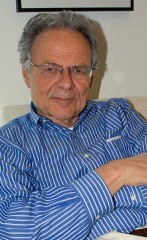
Former senior official Morton Halperin in Washington D.C., May 10.
Halperin suggested that the Japanese Government had followed the United States’ lead in its security policy, and that the attitude of the Japanese Government did not seem to have changed. He said, “I think they both have to take account of the political desires of the Okinawan people and recognize that security policy always has to be determined in the context of the domestic politics of the countries involved, and that you don’t just make security decisions.” He also stressed the necessity of reviewing the bases that “the people on Okinawa do not want,” because it is an excessive burden to them.
In the NSDM 13 that he drafted and Henry A. Kissinger, the aide in charge of national-security issues for President Nixon, signed, the U.S. Government clearly expressed the desire for maximum free use of the military bases in Okinawa. This provided the premise for the Japan-U.S. Joint Committee Agreement known as the “5.15 memo,” which set the conditions for the use of U.S. military bases when Okinawa returned to Japanese sovereignty in 1972.
Based on the 5.15 memo that still holds sway, the two governments concentrate 74% of U.S. military exclusive-use facilities in Okinawa Prefecture, which is just 0.6% area of Japan.
The former senior official stated, “Well at the time we were writing this it was particularly important because there was a war going on in Vietnam and all of Indo-China. I think it’s long past. Reversion occurred many years ago and yet there has been a failure, I think, of both governments to follow up to shrink the bases in Okinawa, the way they’ve been shrinking in Japan.” He suggested there was discriminatory policy against Okinawa between the main islands in the process of reducing the burden of the U.S. bases because the reduction of U.S. military bases has not progressed in Okinawa.
With regard to the secret agreement on nuclear weapons during U.S.-Japan Okinawa Reversion Negotiations in 1969, Halperin commented, “Not retaining, but the right to return them [in the case of a contingency].” Kei Wakaizumi, a secret envoy of the Prime Minister Eisaku Sato, wrote the inside story about the secret negotiation from Japanese side in his book “Tasaku Nakarishi o Shinzemu to Hossu” (The Best Course Available), published in 1994. The late professor of Kyoto Sangyo University was a negotiating partner of Halperin.
(English translation by T&CT, Mark Ealey)
Go to Japanese
May 17, 2012 Hideki Matsudo of Ryukyu Shimpo reports from Washington D.C.
On May 15, the Subcommittee on Military Construction within the Appropriations Committee, which is chaired by Daniel Inouye, rejected the 26 million dollars requested from the draft fiscal 2013 spending bill (for the period October 2012 to September 2013) by the White House for the planned transfer of U.S. Marines in Okinawa to Guam. The Senate plenary session, which will be held soon, is expected to accept this decision by the committee without modification. The Senate Committee on Armed Services (chaired by Carl Levin), which has been tabling the National Defense Authorization Act (NDAA) that decides the outline of the defense budget for fiscal 2013, will undoubtedly move into line with the rejection by the committee, making it likely that the budget for the transfer of Marines from Okinawa requested from the U.S. administration will be turned down for the second consecutive year.
Although in April the Japanese and the U.S. governments reconfirmed their intention to push ahead with the relocation of the U.S. Marine Corps Air Station Futenma to the Henoko district of Nago, and released a joint statement to that effect, they have already come across a snag. The Japanese and the U.S. governments agreed to return part of military facilities and land occupied by the U.S. military south of Kadena Air Base on the premise that the U.S. government will transfer Marines stationed in Okinawa to Guam. If the Senate turns down the budget for the transfer, this may influence the schedule for returning the facilities and land.
The U.S. House of Representatives approved the budget for the transfer of the Marine Corps and the full House is expected to pass the NDAA before the end of May, but it has to pass through both houses of Congress. Because the Senate rejected the defense budget for fiscal 2012, the Japanese and the U.S. governments, which want to see the joint statement on the review of the realignment of U.S. forces in Japan issued in April put into action, it would be a real setback if the Senate turns down the budget again. The NDAA for fiscal 2012 asks the government to submit to Congress a new deployment plan for U.S. forces in the Asia-Pacific region. The Subcommittee on Military Construction within the Appropriations Committee is not likely to accept budget allocated for the planned transfer of Marines in Okinawa unless the details are provided.
The NDAA will get through the committee in the near future and then will be laid on the table in the plenary session. Next week the Subcommittee on Military Construction within the Appropriations Committee is scheduled to adopt the NDAA for fiscal 2013. The committee has been inflexible on the realignment of U.S. forces in Japan, describing the relocation of Futenma Air Station to the Henoko district of Nago unrealistic. The budget for the transfer of the Marine Corps is expected to be rejected.
(English translation by T&CT, Mark Ealey)
Go to Japanese

May 16, 2012 Ryukyu Shimpo
On May 15, the day that Okinawa marked the 40th anniversary of its reversion to Japanese sovereignty, the central government and the Okinawa Prefectural Government co-hosted a ceremony at the Okinawa Convention Center in Ginowan. Prime Minister Yoshihiko Noda expressed his determination, saying, “Futenma base will definitely not be allowed to become a permanent fixture. I pledge to reduce the burden of U.S. military bases.”
Okinawa Governor Hirokazu Nakaima said in his speech, “The Okinawan people are determined to move Futenma Air Station outside of the prefecture and to have the land now used by the U.S. military returned early.”
With regard to the deployment plan of the MV-22 Osprey vertical take-off and landing transport aircraft to Futenma in July, former Minister of the Okinawa Development Agency Kosuke Uehara strongly criticized central government policy on the Okinawa issue, saying, “This represents disdain for the Okinawan people.”
Speeches by hosts and guests at the ceremony reflected the strong dissatisfaction among the Okinawan people with 40 years of excessive burden of the base issue.

Prime Minister Yoshihiko Noda
The ceremony was attended by about 1200 people from Okinawa and outside the prefecture, including the U.S. Ambassador to Japan John Roos, the speakers from both houses, the chief justice of the Supreme Court, and local representatives and representatives from a range of sectors in society.
Outside the ceremony hall, citizen groups staged a protest rally against the government’s policy on the military base issue.
At the ceremony, Prime Minister Noda stated, “Japan-U.S. security arrangements will continue to play a major role. While maintaining a deterrent capability, we will move swiftly to reduce the burden of bases on Okinawa.” Noda also suggested that his government would consider budgeting for the construction of the second runway at Naha Airport in fiscal 2013 and that the administration of Shurijo Castle Park would be transferred to the prefecture from the central government in fiscal 2018. He also indicated the possibility of research into creating a rail system.
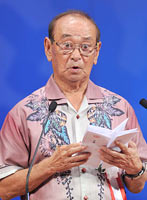
Governor Hirokazu Nakaima
Governor Nakaima stated, “Okinawan people strongly desire that the government radically revise the Status of Forces Agreement between Japan and the United States of America, and want Futenma Air Station to be moved outside of the prefecture and its land returned to its owners early.”
Former Minister Uehara explained the hardships of the Okinawan people and their desire to return to Japanese sovereignty. With regard to situation in Okinawa as it presents itself today – 74% of the U.S. military facilities in Japan are concentrated in the prefecture despite it only having 0.6% area of the country, “This is an abnormal situation,” he said, criticizing the central government’s policy. Uehara requested that the Prime Minister not to build any more bases for U.S. military on the land and sea in Okinawa, and he sought of moving the Futenma base, which is said to be the most dangerous airport in the world, to outside of the prefecture as soon as possible. He disagreed with the deployment of the Osprey aircraft, saying, “This indicates disdain for Okinawa – it is unacceptable.”
(English translation by T&CT, Mark Ealey)
Go to Japanese
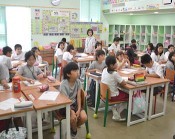
May 11, 2012 Ryukyu Shimpo
On the occasion of the 40th anniversary of the reversion of Okinawa, fifth-grade students of the Okinawa AMICUS International published a school newspaper.
Twenty-seven students worked on the paper from mid-April and draw a comparison between Okinawa in the past and now. By studying about the reversion they are able to gain a perspective of the future of Okinawa and consider what role they should play by discussing the topic.
The students did some research around the keyword “1972.” They looked up books and used the Internet, also interviewing their families. Many of them were surprised that U.S. dollar had been used as currency in Okinawa and that Okinawan people needed a passport to travel to Japan. They wrote the article about what they found out in the research.
On May 8, the school principal, Kazuo Nakasuji, gave a lecture to the students. He was 27 year-old and taught in high school at the time of the reversion. The students asked Nakasuji how did he feel that the sovereignty of Okinawa changed to the U.S. and then back to Japan again. Nakasuji said, “Okinawa has accepted multicultural ideas and developed by our own efforts from the period of the Ryukyu Kingdom, and that spirit is still alive.” The students took notes attentively.
When the students were asked to imagine the future in 40 year’s time, many of them mentioned the U.S. military bases. There were various opinions such as: “I think we should keep the military bases to maintain the balance in our relations with our neighboring countries,” and “I believe that we should get rid of the bases and make them into forest for the indigenous animals of Okinawa.”
Homeroom teacher Joanna Kaoru Uezu said, “Reversion is such a difficult topic for the fifth-grade kids but it is important for them to talk about it. I hope that the students will be curious about issues related to Japan and the world, and see them as relevant to them by knowing about the Okinawan issue.”
(English translation by T&CT, Shinako Oyakawa and Mark Ealey)
Go to japanese
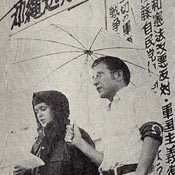
May 15, 2012 Chota Takamine, Correspondent of the Ryukyu Shimpo
On May 15, 1972, the day of Okinawa’s reversion to Japanese sovereignty, an American woman delivered a speech with a U.S. Army sergeant at a protest rally held by the Okinawa Reversion to the Fatherland Council at Yogi Park in Naha. Sixty-one year-old Sharon Danann, an anti-war activist, who currently lives in Cleveland, Ohio, maintains her interest in Okinawa by contributing articles about it to a newspaper for working people in the United States. With regard to the current situation of Okinawa, which recently marked the 40th anniversary of its reversion from U.S. rule to Japanese sovereignty, Danann delivered a message to the people of Okinawa, saying, “On the occasion of the 40th anniversary of reversion, I wish to congratulate you on the clear vision, courageous spirit and amazing organizing in continuing to oppose the fraud of reversion in leaving the U.S. military presence intact.”
In her speech at the protest rally 40 years ago, Danann called Okinawa’s reversion to Japan without the return of the U.S. military bases humiliating, and claimed that she would whole-heartedly support the Okinawan people’s struggle. Danann looked back on that time, saying, “I was bringing solidarity to the rally from antiwar GIs.”

Sharon Danann
Danann said, “There was an overall sense of disappointment and even outrage at how little had changed in the reversion without the land going back to the Okinawan people and the bases being closed.”
Protest rallies and demonstrations against crimes committed by the U.S. military personnel were held in various locations of Okinawa, and Danann and antiwar GIs participated in those. She said, “We really respected Okinawan people’s movement. It was huge.” She said that she had learned a lot through exchanges with Okinawan people.
After going back to the United States, Danann became engaged in various movements such as the GI Antiwar Movement, the Labor Union Movement and the Woman’s Liberation Movement. While working in the Occupational Safety and Health Administration of the United States Department of Labor, she works on race issues and anti-war movements.
Danann stays interested in issues regarding Okinawa, contributing an article about the protest rally against the relocation of the U.S. Marine Corps Air Station Futenma in Okinawa to the Workers World newspaper on June 10, 2010 in which she explains the issues behind U.S. military bases in Okinawa. Danann also contributed an article about the protest rally against the screening of school textbooks by the Ministry of Education, Culture, Sports, Science and Technology to the paper on October 22, 2007.
Danann said, “The Okinawan people have set a bold example of insisting the U.S. occupiers leave and return Okinawa to Okinawans. As someone who rallied and marched with you 40 years ago, I support your struggle whole-heartedly. Now is the time to flex our muscles as a worldwide movement against imperialism, militarism and domination, joining hands around the globe. Onward to victory! Chibariyoo!”
(English translation by T&CT, Mark Ealey)
Go to Japanese
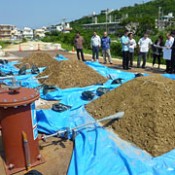
May 8, 2012 Ryukyu Shimpo
On May 7, in anticipation of the use of land after the return of U.S. military bases, Nanyo-doken announced that they have started an experiment involving the biotechnological treatment of soil tainted by heavy oil at a storage site of the company in Urasoe. Applying bacteria found in Japan that can break down oils into the land in Okinawa, they aim to establish technology for soil decontamination that is suitable for use in Okinawa.
The experiment is a part of a prefectural project to develop technology for biological soil remediation. The Kumagai Gumi in Tokyo and the Technos in Aichi have cooperated on this.
Ritsumeikan University discovered bacteria effective for oil degradation, which has now received national authorization, and the Kumagai Gumi will use it. According to the company, experiments using the bacteria have already been conducted within Japan, taking four to five months to clean up the soil. In this test, they will confirm the purification performance on Okinawa’s unique fine-grained soil, which is different from that of other places in Japan.

On May 7, at the office of the Nanyo-doken in Urasoe. Company president Morihiro Higa was enthusiastic about the establishment of technology for soil decontamination.
The method is to have three approaches to soil that includes five grams of heavy oil per one kilogram, one that includes the bacteria which can break the oil down, another that has had Okinawan native bacteria and organic materials added to it, and a control group to which nothing is done. The soil cleanup standard is for one gram of heavy oil to be in per one kilogram of soil, and they will change the frequency of administration of the bacteria as they compare the samples.
After the project, the plan is to establish an association promoting the method of soil remediation. The president of Nanyo-doken, Morihiro Higa, said, “If we become to able to treat oil-contaminated soil in Okinawa locally and therefore don’t need to take it to other prefectures, it means that we can save money and create benefits for construction companies. I hope that we can come up with the very best technology for remediation.”
(English translation by T&CT, Lima Tokumori and Mark Ealey)
Go to Japanese
May 12, 2012 Ryukyu Shimpo
Several government officials revealed on May 11 that the U.S. government has notified Tokyo that it intends to dispatch the MV-22 Osprey vertical take-off and landing transport aircraft to Marine Corps Air Station Futenma in a disassembled state by ship to the Naha Military Port in July, and then will implement test flights after the aircraft have been assembled. U.S. officials said that the Osprey will be deployed to Futenma Air Station in October after test flights and safety inspections have been carried out. But at the same time, the Japanese government has expressed reservations about the plans put forward by the U.S. government, stating, “It is difficult to accept.” With regard to test flights being implemented in a location close to a residential district and the Naha Air Port, Okinawa Governor Hirokazu Nakaima and Naha Mayor Takeshi Onaga, who both oppose the deployment, again complained about the plan.
Washington plans to dispatch the first 12 Osprey aircraft in a disassembled state to the Naha Military Port. The U.S. military then intends to take about a month to assemble the aircraft within the confines of the port.
Some officials of the Ministry of Defense commented, “Test flights of the Osprey in Naha will cause major local protests, which will make the deployment even more difficult,” and others said, “Flights immediately following assembly are susceptible to glitches. We doubt that their safety can be guaranteed.”
The central government is expected to notify the prefectural government of the schedule and procedure for deployment on June 10 after the result of the prefectural assembly election has been announced. The Ministry of Defense intends to request people’s understanding of the deployment by making a brochure explaining the safety issues pertaining to the Osprey.
An Osprey aircraft crashing during a military exercise in Morocco in April has made many people in Okinawa question its safety. The cause of that accident has still not been revealed.
On May 11 at a press conference, Defense Minister Naoki Tanaka acknowledged that the Japanese government is in the final phase of negotiating with the United States on the deployment, saying, “We are definitely now at the stage of carefully explaining the situation to the Okinawan people.” With regard to the specific schedule and procedure for the deployment, Tanaka said, “We want to get final confirmation from the U.S. government as soon as possible.”
(English translation by T&CT, Mark Ealey)















 Webcam(Kokusai Street)
Webcam(Kokusai Street)


